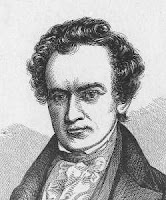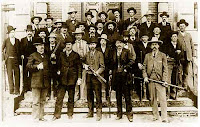Early Texas
The early colonization of Texas was not without difficulty. It began with Moses Austin's journey to Spanish Texas in 1821 to work out an agreement to bring in settlers. The Spanish government agreed to this and Moses started the journey back to Arkansas. On the way back north he was attacked but managed to make it home. Shortly after his return however he became ill and died.
His son, Stephen F. Austin shown at right, was traveling to New Orleans when his father died and after some hesitation agreed to take over the agreement his father had made with Spanish officials. The agreement gave Austin land which he in return sold to the settlers for about 12 1/2 cents per acre.
In 1823 Austin led a group of settlers from the New Orleans area and traveled up the Brazos and Colorado Rivers. The problem was that once he arrived he learned that the new Mexican government decided not to honor the prior Spanish agreement. Eventually the Mexican's came around and Austin and his emigrants were allowed to stay. The reason most likely is that the Mexicans, just like the Spaniards before them, decided that the new settlers would act as a buffer against their many troubles with the Comanches. The Comanches were raiding the Mexican settlements regularly.
The First Texas Rangers
Stephen F. Austin created the Texas Rangers with about 10 men in 1823 to help defend the newly arrived settlers. The Rangers became an official organization in 1835. One of their first duties was to protect the settlers against Comanche attacks. This was the same problem the Spanish and Mexicans endured for many years. The year 1835 saw the Comanche attack on Parker's Fort where the family was massacred and the children kidnapped. The Rangers were also involved in the Texas War for Independence from Mexico and during the border wars in the early 1900's when General Pershing was sent to Mexico in pursuit of Pancho Villa.
John Coffee Hays
The early Texas Rangers were known to be a rough bunch of frontiers men. Shown to the left is John Coffee Hays who was a Captain of the Texas Rangers and had much success against the Comanches (Battle of Plum Creek) and against the Mexicans during their 1842 invasion of Texas.
Hays was one of the early users of the Colt revolver. The Colt revolver was much more effective in battle than a muzzle loading Springfield and the Comanches were quite aware of this. Hays eventually attained the rank of Colonel. When he retired from the Rangers he spent some time as an Indian agent, became sheriff of San Francisco County California and was one of the founders of Oakland, California.
John "Rip" Ford
Another interesting figure in Texas Rangers history was John "Rip" Ford pictured to the right. Ford came from South Carolina to Texas in 1836. He had a long and interesting career having served with John Hays in the Texas Rangers, was in the Texas congress and then a state senator, a Confederate commander, mayor of Brownsville, TX and became a journalist when he purchased the local Austin paper. While in the Texas legislature he was one of the secessionist leaders. Ford was in the last Confederate battle of the Civil War that occurred some three months after Lee's surrender. During the war with Mexico as a Ranger Ford captured a War Chief who happened to be the son of Santa Anna.
Also, see our Western Trips article on the 1890 Clay County Jail
Ben McCulloch
Another well known Ranger was Ben McCulloch from Tennessee. He left Tennessee and tried his hand at various vocations such as mining, trapping and trading but eventually went back to his farm. He decided to join his neighbor Davey Crockett in his journey to Texas in 1835 after Crockett lost a Tennessee Congressional race.
McCulloch was with Sam Houston and the Texas army at the Battle of San Jacinto in 1836. After the war he served as a surveyor, fought against the Mexicans in the War of Texas Independence and was elected to the Republic of Texas House of Representatives. He was a Confederate officer during the Civil War and rose to the rank of brigadier general. McCulloch was credited with several victories over Union forces. Ben McCulloch met his end in 1862 at the Battle of Pea Ridge in Arkansas when he was shot out of his saddle by a Union sharpshooter. Interesting enough, McCulloch disliked military uniforms and at the time of his death was wearing a civilian suit.
Learning about the Texas Rangers is the same as learning the history of Texas. Starting out as a small paramilitary band of frontiers men hoping to give protection to the first settlers, the Texas Rangers grew to be one of the most respected law enforcement agencies in the world and is to this day.
Their budget is set by the Texas legislature. They currently are comprised of 144 officers with a budget to add more if necessary in an emergency. Their headquarters is located within the Department of Public Safety in Austin. The Texas Rangers have hunted down gun fighters and bank robbers during the old western days, pursued Bonnie and Clyde in the early 20th century and continue to be involved in special investigations as well as tracking down wanted felons. They are the elite of Texas law enforcement.
If you are traveling the Texas highways I would recommend a visit to the Texas Ranger Hall of Fame and Museum in Waco, located about half way between Dallas and Austin on Interstate-35.
Below is their web site to help you plan your visit.
www.texasranger.org
Another good site with more information about the Texas Rangers.
www.lsjunction.com/facts/rangers.htm
(Article copyright Western Trips. Photos and images in the public domain)







